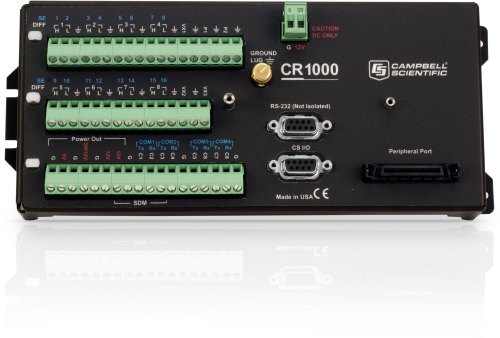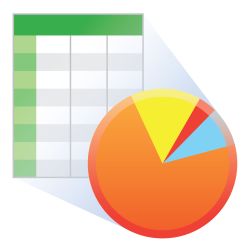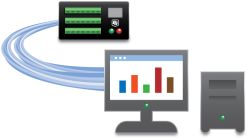This product is not available for new orders. We recommend ordering: CR1000X.

| Services Available | |
|---|---|
| Repair | Yes |
| Calibration | Yes |
| Free Support | No |
Overview
The CR1000 is our most widely used datalogger. It can be used in a broad range of measurement and control functions. Rugged enough for extreme conditions and reliable enough for remote environments, it is also robust enough for complex configurations. Used in applications all over the world, it will be a powerful core component for your data-acquisition system.
Read MoreBenefits and Features
- Ideal applications include fire weather, mesonet systems, wind profiling, weather stations, air quality, ETo/agriculture, soil moisture, water level/stage, aquaculture, avalanche forecasting, time-domain reflectometry, vehicle testing, SCADA, and water quality
- Serial communications with serial sensors and devices supported via I/O port pairs
- Collects and stores data and controls peripherals as the brain of your system
- Flexible power and communication options make it ideal for remote locations.
- 4-MB memory can be expanded with add-on memory systems.
- Supports PakBus, Modbus, SDI-12, and DNP3 protocols
- Compatible with channel expansion peripherals allowing you to expand your system
- Program with LoggerNet, PC400, or Short Cut to fit your setup
- Communicates via various options: TCP/IP, email, FTP, web server.
- Gas Discharge Tube (GDT) protected inputs
- Battery-backed clock that ensures accurate time is maintained while data logger is disconnected from battery power
- Program and control on site with addition of CR1000KD keyboard and display unit.
- Contains custom ASIC chip that expands pulse count, control port, and serial communications capabilities
Please be advised that Campbell Scientific is nearing discontinuation of the CR1000 Measurement and Control Datalogger. The CR1000 will be available for order through 31 Jan 2020. You will not be able to purchase a CR1000 after this date. Refer to the CR1000 Discontinuation Notice for details.
Technical Description
The CR1000 consists of a measurement and control module and a wiring panel. This datalogger uses an external keyboard/display and power supply. Low power consumption allows the CR1000 to operate for extended time periods on a battery recharged with a solar panel—eliminating the need for AC power. The CR1000 suspends execution when primary power drops below 9.6 V, reducing the possibility of inaccurate measurements.
The CR1000's module measures sensors, drives direct communications and telecommunications, reduces data, controls external devices, and stores data and programs in on-board, non-volatile storage. The electronics are RF shielded and glitch protected by the sealed, stainless-steel canister. A battery-backed clock assures accurate timekeeping. The module can simultaneously provide measurement and communication functions. The on-board, BASIC-like programming language supports data processing and analysis routines.
The CR1000WP is a black, anodized aluminum wiring panel that is compatible with all CR1000 modules. The wiring panel includes switchable 12 V, redistributed analog grounds (dispersed among analog channels rather than grouped), unpluggable terminal block for 12 V connections, gas-tube spark gaps, and 12 V supply on pin 8 to power our COM-series phone modems and other peripherals. The control module easily disconnects from the wiring panel allowing field replacement without rewiring the sensors.
Originally, the standard CR1000 had 2 MB of data/program storage, and an optional version, the CR1000-4M, had 4 MB of memory. In September 2007, the standard CR1000 started having 4 MB of memory, making the CR1000-4M obsolete. Dataloggers that have a module with a serial number greater than or equal to 11832 will have a 4 MB memory. The 4 MB dataloggers will also have a sticker on the canister stating “4M Memory”.
Images













3D/CAD Files:
Compatibility
Please note: The following shows notable compatibility information. It is not a comprehensive list of all compatible products.
Measurement and Control
| Product | Compatible | Note |
|---|---|---|
| SDM-SIO2R |
Software
| Product | Compatible | Note |
|---|---|---|
| LoggerNet | Version 3.0 or higher | |
| PC200 (retired) | ||
| PC400 | Version 1.2 or higher | |
| PCONNECT (retired) | Version 3.1 or higher | |
| PCONNECTCE (retired) | Version 2.0 or higher | |
| RTDAQ | Version 1.0 or higher | |
| Short Cut |
Additional Compatibility Information
Sensors
With several channel types, the CR1000 is compatible with nearly every available sensor, including thermocouples, SDI-12 sensors, and 4 to 20 mA sensors (via a terminal input module, such as the CURS100). A custom ASIC chip expands its pulse count, control port, and serial communications capabilities. The CR1000's I/O ports can be paired as transmit and receive, allowing serial communications with serial sensors and devices.
Measurement & Control Peripherals
The CR1000 is compatible with all of our CDMs (requires an SC-CPI), SDMs, multiplexers, vibrating-wire interfaces, terminal input modules, and relays.
Communications
The CR1000 communicates with a PC via direct connect, Ethernet interfaces, multidrop modems, short-haul modems, phone modems (land line, digital cellular, and voice-synthesized), RF telemetry, and satellite transmitters (Argos, Iridium, and Inmarsat).
Data can be viewed on the CR1000KD Keyboard Display, the CD100 Mountable Display with Keyboard, an iOS or Android device (requires LoggerLink), CD295 DataView II Display, or a user-supplied PDA (PConnect or PConnectCE software required).
Compatible external data storage devices are the CFM100, NL115, and SC115.
Enclosures
The CR1000 and its power supply can be housed in any of our standard enclosures.
Power
Any 12 Vdc source can power the CR1000 datalogger. Power supplies commonly used with the CR1000 are the BPALK, PS150, and PS200. The BPALK provides eight non-rechargeable D-cell alkaline batteries with a 7.5 Ah rating at 20°C.
Both the PS150 and PS200 consist of a sealed rechargeable 7 Ah battery and a charging regulator. Their battery should be connected to a charging source (either a wall charger or solar panel). These two power supplies differ in their charging regulator. The PS150 has a standard regulator and the PS200 has a micro-controller-based smart regulator. The PS200's regulator provides two-step constant voltage charging and temperature compensation that optimize battery charging and increases the battery’s life.
Also available are the BP12 and BP24 battery packs, which provide nominal ratings of 12 and 24 Ah, respectively. These batteries should be connected to a regulated charging source (e.g., a CH100 or CH200 connected to a unregulated solar panel or wall charger).
Software
CRBasic, the CR1000's full programming language, supports simple or complex programming and many onboard data reduction processes. Compatible software includes:
- Short Cut
- PC200W
- PC400 (version 1.2 or higher)
- LoggerNet (version 3.0 or higher)
- RTDAQ (version 1.0 or higher)
- PConnect (version 3.1 or higher)
- PConnectCE (version 2.0 or higher)
- VisualWeather (version 2.0 or higher)
Specifications
| -NOTE- | Additional specifications are listed in the CR1000 Specifications Sheet. |
| Operating Temperature Range |
|
| Analog Inputs | 16 single-ended or 8 differential (individually configured) |
| Pulse Counters | 2 |
| Voltage Excitation Terminals | 3 (VX1 to VX3) |
| Communications Ports |
|
| Switched 12 Volt | 1 terminal |
| Digital I/O |
|
| Input Limits | ±5 Vdc |
| Analog Voltage Accuracy | ±(0.06% of reading + offset) at 0° to 40°C |
| ADC | 13-bit |
| Power Requirements | 9.6 to 16 Vdc |
| Real-Time Clock Accuracy | ±3 min. per year (Correction via GPS optional.) |
| Internet Protocols | FTP, HTTP, XML, POP3, SMTP, Telnet, NTCIP, NTP |
| Communication Protocols | PakBus, Modbus, DNP3, SDI-12, SDM |
| Warranty | 3 years |
| Battery-backed SRAM for CPU Usage & Final Storage | 4 MB |
| Idle Current Drain, Average | < 1mA (@ 12 Vdc) |
| Active Current Drain, Average |
|
| Dimensions |
|
| Weight | 1.0 kg (2.1 lb) |
Resources and Links
Product Brochures
Technical Papers
- FTP Streaming
- Benefits of Input Reversal and Excitation Reversal for Voltage Measurements
- Preventing and Attacking Measurement Noise Problems
- DNP3 with Campbell Scientific Dataloggers
- Voltage Accuracy, Self-Calibration, and Ratiometric Measurements
- BACnet to Modbus Protocol Conversion (App. Note: 1M-C)
- AlphaGUARD Radon Monitor Interfaced with the CR1000 Datalogger
- Serial Sensors: Interfacing with CSI Dataloggers (App. Note Code: 2MI-V)
- PC/CF Card Information (3SM-F)
Case Studies
Compliance
Miscellaneous
Videos & Tutorials
Downloads
CR1000 OS v.32.07 (4.60 MB) 15-05-2024
Execution of this download installs the CR1000 Operating System and Compiler on your computer. It also updates the CR1000 support files for the CRBasic Editor.
Note: This OS has crossed the 2 Meg CR1000 size limit for remote download. The OS must be downloaded to the 2 Meg CR1000 via direct connect with the Device Configuration Utility. All OS download methods are supported by the 4 Meg CR1000.
Upgrading from versions prior to version 28 of the Operating System will reset the datalogger’s CPU drive. This is due to a change in the format of the file system from FAT16 to FAT32. In order for the datalogger to operate correctly, as part of the upgrade, the CPU drive is formatted to FAT32. Any programs stored and running from the CPU drive will be lost. It is not recommended to update the datalogger’s Operating System over a remote connection where program control regulates the communication equipment (turning it on or off, etc.). In these cases, an on-site visit and a backup using DevConfig’s backup utility is necessary to update the datalogger’s Operating System.
Watch the Video Tutorial: Sending an OS to a Local Datalogger.
In all cases where the datalogger is being updated from an Operating System prior to 28, the use of DevConfig’s backup utility is recommended due to the CPU drive being formatted using the new FAT32 format.
Device Configuration Utility v.2.32 (47.7 MB) 19-03-2025
A software utility used to download operating systems and set up Campbell Scientific hardware. Also will update PakBus Graph and the Network Planner if they have been installed previously by another Campbell Scientific software package.
Supported Operating Systems:
Windows 11 or 10 (Both 32 and 64 bit)
FAQs for
Number of FAQs related to CR1000: 185
Expand AllCollapse All
-
The potential transformer and the current transformer provide differential outputs that have galvanic isolation from the voltage and current in the circuit they are measuring. However, there is no need to run the outputs of these transformers into differential inputs of the data logger and unnecessarily consume additional data logger channels. We conducted extensive testing for noise immunity, for inaccuracies from ground loops, and more before concluding that single-ended measurements in the ACPower() instruction have the same performance as differential measurements would provide. Please note that as a result of the galvanic isolation of the potential transformer and current transformer, the data logger ground is NOT connected to the ground of the circuit they are measuring.
Said differently, you can connect differential outputs of a sensor to single-ended inputs of the data logger. However, doing so creates the possibility of poor common-mode noise rejection in the data logger and the possibility of introducing inaccuracies from ground loops between the sensor and the data logger. Note that in this application, the transformer isolation of the potential transformer and the current transformer eliminates these concerns.
Simply connect one of the potential transformer secondary wires and one of the current transformer secondary wires to the data logger ground. Which wire in either case makes a difference, as the phase information allows the measurement of power flowing in either direction. If you measure negative real power when it should be positive, then reverse the secondary wires of the potential transformer where they connect to the data logger. Alternatively, you can reverse the secondary wires on the current transformer, but don't reverse both pairs of wires.
-
Calibration of the CR1000 is recommended every three years.
-
The control port maximum output current is 5 mA, but the port is current limited. The voltage will drop to 0 V with an output of 5 mA. Expect no more than 1 mA at 5 Vdc.
-
The data logger’s Status table has a LastSystemScan field that provides this information.
-
Yes, provided the serial sensor is connected to a port that is separate from the one used to connect to LoggerNet.
-
In OS 24, any delay in the CR1000 communication while reading a server certificate is because the datalogger has to work its way through the certificate and set up the encryption to continue with secured communication. This speed depends on the processing power of the datalogger.
-
Use the PreserveVariables() instruction to ensure that all variables reflect the last known value if the data logger experiences power loss.
-
Only one CWB100 can be connected to each odd channel control port. For the CR800 and CR850, this relates to two total units—one on C1 and one on C3. On the CR1000 and CR3000, this amounts to four total units.
Putting more than one CWB100 on a data logger will NOT speed up sensor data collection. Only one CWB100 should be accessed at any given time, or the devices will interfere with each other. If multiple CWB100 devices are connected to a single data logger, the data collection schedules for the CWB100 devices should be staggered. Sufficient time should be built in to allow each base unit to collect data from all of the remote sensors associated with it and to allow for any needed retries.
-
RS-232 is not a multidrop interface. This means that the connection can only be between two devices. SDI-12 and RS-485 two-wire are multidrop interfaces, allowing several devices to be connected to the same port. Only a single RS-232 device may be connected to a COM port. Using an RS-485 to RS-232 interface, several RS-485 devices may be connected to a single COM port.
Case Studies
Tropical volcanic islands are biodiversity hotspots where the Critical Zone (CZ) remains poorly studied. In......read more
Background In 2022, ECR Medio Ambiente assumed the responsibility of overseeing the structural monitoring installation at......read more
Overview The Chauvet-Pont d'Arc and Aven d'Orgnac caves are home to prehistoric treasures of rare artistic......read more
In 2013, a sinkhole appeared next to a historic home in southern Louisiana. Over the......read more
CS110 Electric Field Meter to Recreate the Carnegie Curve of Earth's Fair-Weather Electric Potential Gradient INESC......read more
The Problem The Lakhta Tower is a building that was completed in 2018, designed for both......read more
The Hong Kong-Zhuhai-Macao Bridge (HZMB)—comprising viaduct bridges, cable-stayed bridges, a submerged tunnel, and artificial islands—is......read more
Steve Rodgers is the lab manager at the Aquaculture Research Center of the Institute of......read more
Articles and Press Releases
Newsletter Articles
- Celebrate with Us! 24-01-2018
- Case Study: High-Elevation Weather in Peru 21-07-2016
- Case Study: Dam Monitoring in Puerto Rico 02-02-2016
- Case Study: Geothermal Development in Colombia 02-02-2016
- Case Study: Solar-Energy Assessment in Chile 20-10-2014
- Case Study: Flood Warning in Arkansas 15-10-2013
- Case Study: Preventing Road Damage from Freezing Conditions in South Korea 09-05-2013
- Case Study: North Carolina “Green” Hotel 18-10-2012
- Case Study: Florida Water Diversion Control 18-10-2012
- Case Study: Researching Glacier Retreat in the Andes 17-08-2012
- New Operating System for CR800, CR1000, CR3000 17-08-2012
- Case Study: Station Provides Flood Warning & Road Weather Data 17-08-2012
- Case Study: Water-Supply SCADA System 15-03-2012
- Case Study: Post-Tensioned, Fiber-Reinforced Bridge 16-11-2011
Privacy Policy Update
We've updated our privacy policy. Learn More
Cookie Consent
Update your cookie preferences. Update Cookie Preferences
































